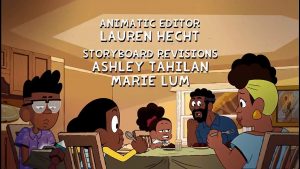Representation matters. Hollywood knows that now more than ever before. But Hollywood is also cunning and exploitative, as we all know. People of all sexes and colors want a reflection on screen, and if it’s diversity that sells then it’s diversity we’ll get. Inclusion in many ways has just become another thing for filmmakers to either exploit or embrace. It’s a war between being thoughtless and being thoughtful. People of all types are actually getting screen time whereas they would not have before.
To bring this all into familiar territory for us animation students, let’s have a look at Cartoon Network’s Craig of the Creek: a cute, harmless show that turns the local woods into a mini world of gest and adventure for the local kids to explore. It’s Recess meets Lord of the Rings, essentially. What has people tied up about it is the fact that the show was created by two white guys (Matt Burnett and Ben Levin) but its protagonist, Craig, and his family are black.

Hey Arnold! and Recess are similar cartoons to Craig of the Creek in that they follow the suburban, slice-of-life adventures of kids helping others or getting into trouble. Arnold Shortman and T.J. Detweiler are the protagonists of each show, respectively. Both are white males with a black best friend. Gerald and Vince are great, but would it really hurt to make “the black guy” the protagonist, for once? Black kids growing up wouldn’t have to keep relating exclusively to side characters. Matt Burnett says, “I think more inclusivity and media and representing people that we haven’t usually seen on TV is really exciting.”
Craig of the Creek’s creek is in a modest, middle-class neighborhood, where Craig is treated no differently than any other of the diverse kids. He’s a middle child whose mother, father, and grandparents care for him. There’s no commentary on race or on growing up black in America within the show, but Craig of the Creek isn’t that kind of show anyways. It’s an innocent, wistful trip back to childhood whose protagonist happens to be black. There is no one way to grow up black in America, and Burnett and Levin make Craig fun and relatable as any kid. Burnett and Levin are Steven Universe veterans, so rest assured no one will misuse representation. Besides, if it weren’t for white filmmakers representing other races, we wouldn’t have strong minority characters like Moana or Miguel.
It is worth noting that the show isn’t two white men assuming the black experience. Burnett and Levin have gathered a diverse crew to ensure that black voices are being heard from the show through their boards and words in the script. “We worked hard to put together the team that would help shape the show, a very diverse group of voices to add something that we needed that we couldn’t do on our own. That was always our goal when we decided to create the show, to work with a huge range of people and get their voices heard on TV,” says Burnett.
Choosing to represent those of us cast in others’ shadows, whether it be women or minorities, is a bold opportunity that can break grounds. Other times, it can be hasty and underhanded. Two of Pixar’s last films feature major female characters who were both male until late in production: Cruz Ramirez in Cars 3 and Evelyn Deavor in Incredibles 2 (Evelyn’s change came so late that her male version was already fully modeled, rigged, and textured). The filmmakers explain that Cruz was made a female to seem like an outsider in the male-dominated racing world and Evelyn was made female to give her a stronger relationship with Elastigirl: two women cast in men’s shadows. These last-minute changes aren’t malicious or anything, but they aren’t exactly noteworthy either. They seem hasty. They do have thought and nuance put into why they made their decision to make the change, though, it’s not like J.K. Rowling coming out saying “btw Dumbledore was gay.” And at the end of the day, kids have a Latina racer and female supervillian.
Everyone wants a character to relate to and it’s disheartening when you can’t find yourself anywhere. Craig of the Creek isn’t exploiting Black America; it’s embracing childhood and diversity. Every day ends with Craig and his friends running home just in time for dinner, and every credit sequence is an intimate, warm look at Craig’s family dinner table. Melodic indie rock plays as we see the whole family together, just eating, happy together. Levin likes this moment and says of it, “People have pointed that out, like, ‘this is so refreshing to see on television.’ We’re looking to show those little moments. They’re not big political statements, but they can mean so much to people.” As groundbreaking as it may be, I don’t think the creators would want their show to be remembered just as “the one with the black kid.” Luckily, I think they have just enough fun and creativity within the show for it’s legacy to be broader than that. There’s something for everyone in Craig of the Creek, and that’s what makes diversity endearing.

https://nerdist.com/craig-of-the-creek-5-reasons-you-should-watch/
https://www.youtube.com/watch?v=TWVfw-0qv6c
http://blacknerdproblems.com/craig-of-the-creek-review/
